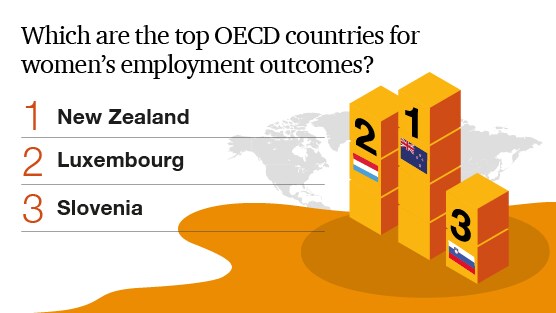This year, we celebrate a decade of PwC’s Women in Work Index. The report gives us an opportunity to reflect on the very real impacts of the COVID-19 pandemic on women’s lives, jobs, economic prosperity, and broader wellbeing; and importantly to look towards the future.
In 2020, the Women in Work Index fell for the first time in its history due to impacts of the COVID-19 pandemic. After a decade of slow but steady improvement in women’s employment outcomes, progress towards gender equality in work was set back by at least two years across the 33 Organisation for Economic Cooperation and Development (OECD) countries in our analysis. Women’s employment losses from the COVID-19 pandemic were relatively worse than men’s. This was demonstrated by higher female unemployment rates and lower female labour market participation in 2020 across the OECD.
Around the world, economies are recovering from the damage done by the COVID-19 pandemic; and government and business action to address the climate crisis is higher than ever. The new green jobs being created in the transition to net zero present huge opportunities for economies and workforces globally.
Explore the key findings from the research below and find out what governments and organisations can do to improve outcomes for women in work, and lay down a blueprint for a sustainable, prosperous, and inclusive future world of work for all.
You can also explore the Women in Work Index results at a country level using our interactive data tool.
If you have any questions about our research, please do not hesitate to get in touch.
The global view
For the first time, New Zealand tops the Women in Work Index with Luxembourg and Slovenia taking second and third place. The UK is the biggest climber in the rankings, while Canada suffers the largest slide.

UK performance
The UK moved up seven places on the Index in 2020, from 16th position in 2019, to rank ninth out of the 33 OECD countries. This puts it in first position among the G7 economies for the first time in the history of the Index.
Lower-performing regions of the UK showed greater improvement in 2020 than those ranked at the top. This helped to narrow the gap between the best and worst performing nations and regions, indicating an improvement in equality in employment outcomes geographically, for women across the UK.

The impact of net zero
The next decade of Women in Work will be shaped by the transition of global economies to net zero: the corresponding green jobs created, and the demand for associated green skills.
As it stands, women are currently at a disadvantage: previously slow progress towards equality was set even further back by the pandemic; and the transition to net zero will further perpetuate inequalities unless there is targeted intervention.
Our analysis of the energy sector’s transition to net zero shows that across the OECD, new green jobs created will be concentrated in only a few sectors: utilities, construction, and manufacturing being the clear top three. These sectors employ nearly 31% of the male workforce across the OECD, compared to only 11% of the female workforce. With new jobs concentrated in sectors that are male-dominated, men are immediately better placed to take advantage of the new opportunities.
If nothing is done to increase women’s representation in these green growth sectors, we estimate that the employment gap between men and women across the OECD will widen by 1.7 percentage points by 2030, rising from 20.8% in 2020 to 22.5% in 2030 (instead of 22.0% in the case that OECD economies did nothing to address the climate crisis).
Inclusive policies for a fairer future
In addressing the climate crisis head on, we must learn from the mistakes of the pandemic, and focus on designing gender responsive policies that will enable women to have equal access to future job opportunities.
Equipping women with the right skills to successfully navigate the green jobs market is one side of the equation. This will help to create greater economic security for women by improving access to high quality and sustainable jobs in markets of long-term growth.
The other side of the equation is building a future world of work that better meets the needs of women and other marginalised groups.
In this future green world of work we must offer:
- Flexible working options
- Affordable childcare
- Equal paid parental leave
Flexible working options
Flexible working options must be accessible and equally used by everyone, both women and men, such that flexible working is accepted as standard practice, and there are no conscious or unconscious gender biases against those who work flexibly.
Affordable childcare
More affordable childcare options are needed to help to reduce the burden of unpaid care carried by women.
Equal paid parental leave
Equal paid parental leave policies are needed from governments and businesses, to help redistribute women’s burden of unpaid care. This will allow women to increase participation in paid work, and provide better opportunities for career advancement. This will also help to narrow gender pay gaps.
Only when women and men are considered equal in undertaking childcare and domestic work, can gender equality at work become an achievable reality.
As we look towards a fairer, greener future, we need governments, and even more importantly businesses, to lead the way by rebuilding our economies and societies with good policies and practices that put women’s needs at the centre, and are designed using an intersectional analytical framework. This will allow us to design-in equality to our future, and finally #BreakTheBias. It is not enough to imagine a gender equal world; we must all do our part to create it.
Contact us
















